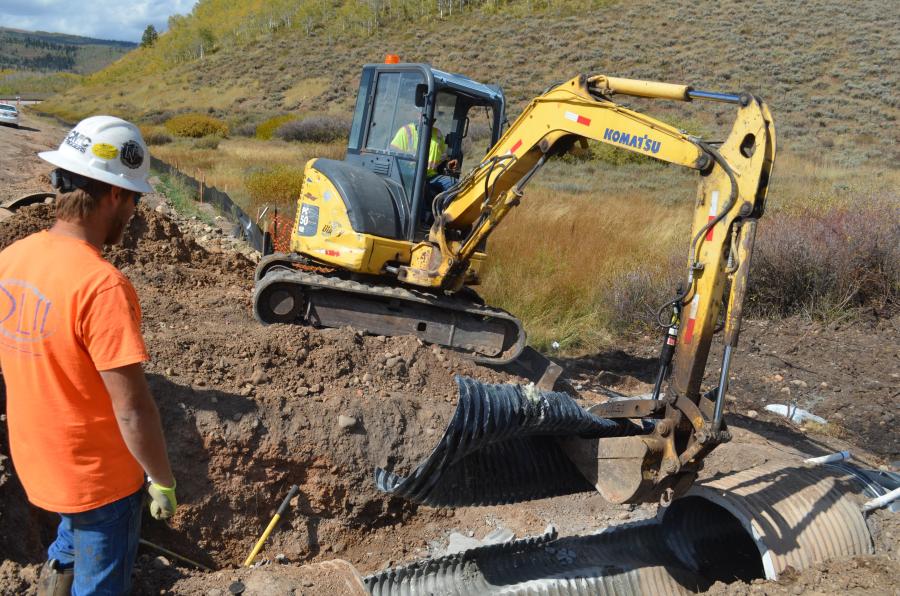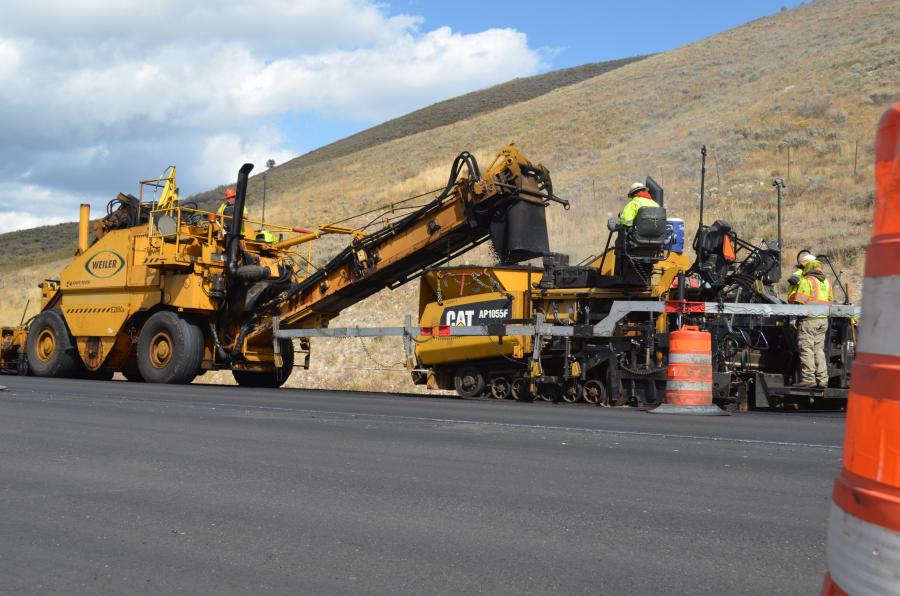Deemed one of Utah Department of Transportation’s Top 10 Projects for 2019, the $37 million U.S. 40/Strawberry Valley Passing Lanes project will add 5 mi. to an existing westbound passing lane and will repave 18 mi. from Daniels Summit to Soldier Creek.
(UDOT photo)
Deemed one of Utah Department of Transportation (UDOT)'s Top 10 Projects for 2019, the $37 million U.S. 40/Strawberry Valley Passing Lanes project will add 5 mi. to an existing westbound passing lane and will repave 18 mi. from Daniels Summit to Soldier Creek.
Construction began a few months ago, and continues through next summer.
"The project is advancing well," said Jason Richins, UDOT project engineer. "We have hit many milestones. Due to the high altitude and a short construction season, it will take two seasons to complete the 17-mi.-long project. There were some weather and wetland permit delays at the beginning of the season, but we have made great progress since then."
U.S. 40 is the main corridor that connects eastern Utah to the more populated area of the Wasatch Front. The roadway serves multiple users, including truckers and commuters, making it a key east-west connection for the state.
Because of the high elevation, this rural area experiences early and late snow storms and cooler temperatures compared with valley levels. The roadway also runs along a wetland area and with the additional moisture, it created several soft spots on the shoulders that needed to dry out before crews could start widening the highway.
"It's also used for ranching, and is an active wildlife area," said Richins. "This required us to better secure the work area to improve safety for the construction crews and the large animals moving through the project area. We even encountered beaver dams that affected our drainage systems and some of our other work."
Unexpected Issues
Construction crews have already had to deal with some unexpected issues.
"We had one of the wettest winters in Utah, and the project area is around 8,000 ft. in elevation. Crews were planning to start in April, but at that time we still had several feet of snow, which delayed their work until May. Other challenges included drainage culverts, intended to be relined, that were actually crushed and needed to be replaced. Fiber optic lines needed to be relocated, and with the amount of roadway excavation, the contractor had to increase the number of borrow sites to store the extra material"
Work on the eastern 6 mi., between milepost 46 to 52, is almost finished. Nearly all the drain pipes and culverts have been replaced or relined, and conduit has been relocated and extended throughout the project limits. The middle 6 mi. are scheduled to be completed in 2020, as part of the effort to rebuild the pavement.
Currently, crews are paving the two initial layers of pavement in the widened areas.
"The wildlife fencing also is being installed," said Richins. "Our contractor, Knife River, is finishing the side slope treatments, replanting the area and removing erosion control materials from the roadway.
"The fiber line has been relocated and extended throughout the project limits, and traffic cameras are being installed. Also, a Roadway Weather Information System (RWIS) is being installed near the Strawberry Marina turnoff. These features will enable us to gather traffic and road condition data, monitor conditions and provide real-time information to the traveling public. Throughout the winter, we will be extending the box culvert at the Strawberry River."
Making Room
Extending the passing lanes required widening the slopes on both sides of the roadway, along with relocating utility while minimizing impacts to wetlands in the area. Box culverts needed to be extended. The curves and cross street connections are being raised and extended to connect properly with the widened roadway.
"Half the new westbound passing lane will be opened to traffic this winter, and the remaining section will be completed in 2020," said Richins. "Once the work is complete, there will be an added benefit for eastbound drivers in that the road will be striped, so those heading east can pass slower moving vehicle, as long as there's no oncoming traffic from the west and it's safe to do so."
Repaving 18 mi. from Daniels Summit to Soldier Creek brings its own share of obstacles.
"Crushing and processing materials, coordinating haul trucks and traffic control are the biggest challenges. The project had to be split into segments to reduce travel delays where possible. In some locations, traffic had to be reduced to a one-way configuration, which requires the use of flaggers and pilot car operations to safely move motorists through the work zones. Because of the high elevation of the area, it shortens the construction season, which requires a greater effort to maximize the work being done on a daily basis."
Creating Safe Crossings
The wildlife crossing is already complete. Three existing box culverts will be used as crossings, as well. Ten mi. of wildlife fence will be put in place to reduce collisions and improve safety.
The wildlife structure is made of galvanized steel and built with corrugated plates that, when assembled, make an ellipsis. The underpass dimensions are approximately 16 ft. high, 27 ft. wide, with a length of 110 ft. The contractor phased the construction building half the underpass at a time.
"The contractor elected to use sheet piles instead of grading back the slopes, which saved time in excavation and backfill work," said Richins. "A detour was built to move traffic to the south, so that the north half of the underpass could be built. A retaining wall was built so that the contractor could backfill the north half of the underpass. Once the north phase of the underpass was built, traffic was switched over to the new road section, and the southern half was built. The concrete headwalls still need to be poured, but will be done next spring."
According to UDOT project manager Larry Montoya, now is the time to perform the work.
"Around 2008, UDOT performed a Cold-in-Place recycle (CIR) project. That asphalt layer never fully set up, and began to deteriorate in places and it became necessary to rebuild the pavement to eliminate any future problems, such as potholes in the roadway."
In this portion of U.S. 40, the roadway is mostly a two-lane highway, with long stretches between passing lanes.
"UDOT had applied several treatments to preserve and extend the life of the road over the last several years," said Montoya, "but as we investigated the asphalt layers underneath the surface, we noticed signs of deterioration, so a much larger effort was needed to rebuild the pavement so it can last for years to come."
Borrow Project
Joshua Werner, project manager for contractor Knife River Construction, described the undertaking as a borrow project.
"We identified three slopes, and worked to gain the proper environmental permits, so that material could be reused as granular borrow within the project. The slopes of the hills along the highway were making it difficult for drivers to see oncoming traffic as they entered into a curve in the roadway. As crews reduced these slopes, it not only improved a driver's vision of what was coming, it also provided more earthen material to be reused within the project.
"As this area is more remote, it required us to bring in granular borrow and untreated base from approximately 10 miles away. To improve operations, we would haul the asphalt tailings to the pit, and reload with granular borrow or untreated base course and haul those materials back to the project."
A total of 30,000 cu. yds. of borrow will be moved on the project, which also calls for 220,000 tons of asphalt and 500,000 sq. yds. of roto milling. Heavy equipment used on the project will include Caterpillar (Cat) 1055D and F pavers, a Weiler E2850A material transfer vehicle, Cat DB15 double drum rollers, a Cat CCS9 roller, distributor and water trucks, Cat 349F, 336F and 325F excavators, Cat 14H and 160H motor graders, a John Deere 750 K dozer, Cat 950K loaders, a Cat CS54 roller and a Dynapac smooth drum roller.
Main materials will include pipe culvert extension and liner material, precast wildlife guards, elliptical steel plate structure, wildlife fencing poles and wire, fiber optic and conduit, signs, delineators, paint, precast barrier and guardrail, granular borrow, untreated base course, HMA and lightweight chip seal.
Richins acknowledged that the changing weather has made construction difficult at times.
"We had a heavy snow pack this spring that took a long time to melt. We also had a lot of rain, which kept the ground saturated and affected the cut ditches that needed to be filled so that we could start widening the road. Once the area dried out, crews were able to get to work through the late spring and summer. We also encountered some severe summer storms, which also impacted our schedule."
Teamwork Conquers Obstacles
Richins noted that the project's many partners have provided a great deal of support and assistance.
"The team worked together to problem-solve issues and find solutions. We appreciate the dedication of Utah Highway Patrol (UHP) to ensure safety on the project. We also were supported by UDOT Motor Carrier Division, UDOT Port of Entry, U.S. Forest Service, Utah Department of Natural Resources, U.S. Army Corp of Engineers, utility companies, local radio stations and governments."
The project has an end date of fall 2020. Because U.S. 40 is the only route connecting eastern Utah to the urban area of the Wasatch Front, keeping traffic moving while rebuilding and adding 5 mi. of passing lanes is critical.
"Where possible, we are able to keep one lane open in each direction," said Geoff Dupaix, UDOT communications manager. "In other areas, we have had to move traffic to a one-way situation where the contractor uses flaggers and pilot vehicles to keep things moving. This is also a primary route to several recreation areas, so all lanes remain open at night and on weekends. While travel delays are necessary, our contractor has worked hard to keep them to approximately 10 minutes."
Dupaix said that while much work remains, the construction team is making steady progress. He added that completing the project will be extremely satisfying for everyone involved.
"Anytime we can enhance safety, preserve our infrastructure, reduce travel delays or provide more transportation choices to improve our communities, it's very satisfying. You can look back and see what has been accomplished, and get energized to face future challenges." CEG
Today's top stories


























